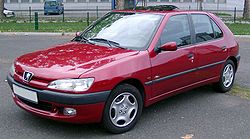Blog Archive
Background
The 306 was developed between 1990 and 1992 ready for 1993. It was a replacement for the Peugeot 309 (which had broken with Peugeot's normal ascending numbering system partly due to it being released before the older and larger Peugeot 305 was axed).Mechanically, the 306 is virtually identical to the Citroën ZX, which was launched two years before the 306: both cars use the same floorpan and core structure. The 306, with its attractive Peugeot 205 derived Pininfarina styling, was a more successful car than its twin. The Citroen Berlingo and Peugeot Partner were also built on the same platform. The chassis used by the 306 and ZX was also used in the ZX's replacement, the Citroën Xsara. The sharing of platforms between Peugeot and Citroën has been parent company PSA Peugeot Citroën policy since the late 1970s, after the Peugeot takeover of the then bankrupt Citroen in the wake of the 1974 oil crisis. The first car being the Peugeot 104 based Citroen Visa and Citroën LNA. The policy continues today with the Peugeot 107, Citroen C1 and Toyota Aygo.
306 Phase 1
A bewildering array of different model types were offered during the life of the Phase 1 model, including Genoa, XSS, X, XT, XRdt and Xd. Later were added various 'performance' models, such as the S16, XSi and GTI-6 (petrol) and the D-Turbo S (diesel).
All variants of the 306, with the exception of the GTI-6 and cabriolet models, were priced very competitively.
Petrol engines
The initial petrol engines used were proven four-cylinder units, which had gained a solid reputation in Peugeot models such as the 205, 309 and 405. At first, all mainstream models were powered by derivatives of the TU series 8-valve engine, in 1.1, 1.4 and 1.6 litre guises. The 1.1 was dropped quickly, but the 1.4 and particularly the 1.6 variants sold well; the latter offering a good balance between performance and economy.Three larger-capacity units were available, but restricted to automatic and performance models. These engines were developments of the larger XU series units which had been used in the 205 GTi 1.9, and larger 405 models. A 1.8 litre version powered cars with both manual (not many 1.8 manuals were produced) and automatic transmission; while two versions of the 2.0 litre engine in 8- and 16-valve guises powered the XSi and S16 models respectively. In Australia, the only engines available were the 1.8 and 2.0L engines
Diesel engines
Peugeot had an excellent reputation for its diesel engines, and the 306 was originally offered with the XUD series diesel engine in both normally-aspirated and turbocharged forms. This engine was initially a 1.8 litre unit, but its capacity was soon enlarged to 1.9 litres. The turbocharged version quickly gained a reputation for being a good match for the exceptional handling of the 306. Not only did its outright performance match many similarly-sized petrol cars – almost certainly a first for an affordable mainstream diesel – but the carefully-designed installation ensured its considerable extra weight did not upset the car's handling. The Indirect Injection XUD Diesel is popular for conversion to run on vegetable oil.Chassis design
The PSA powertrains, described above, drove the front wheels of a chassis with a seemingly conventional design. At the front was a standard McPherson strut layout with anti-roll bar, while the rear used a semi-independent trailing arm/torsion bar set up. However, Peugeot's chassis engineers employed some unusual features, including passive rear wheel steering (by means of specially designed compliance bushes in the rear suspension), and in-house developed and constructed shock absorbers. The diesel and larger capacity petrol engines are canted as far back as possible in the engine bay in an effort to put as much weight as possible behind the front axle line, improving weight distribution, and minimising understeer. The 306 was regarded as the best handling small family car of its time.Versions
Trim levels were XN, XL, XR, XT and XS; XN being the most basic, and XT the highest specification. The XR and XT were available in 5-door only, with the XN and XL available in 3-door too. The D-Turbo and XSi were available in both 3- and 5-door, the XS and S16 only available in 3-door. There were no longer "X/G" designations ("X" indicating a 3-door, "G" indicating a 5-door). x A diesel model could be identified with the addition of "d" after the spec level, and a turbodiesel with the addition of "dt". There were special edition versions too, badged "Alpine" from 1994. (3-door only).Sedan models
Sedan specification was marked as SN, SL, SR, and ST. The Sedan model, for many motorists provided an alternative to the domination of the car markets by hatchbacks and was hailed at the time by Jeremy Clarkson amongst others..The sedan model was compared by Whatcar Magazine as being an inferior "Brother" to the Peugeot 405, but this is not true to a certain extent, the 306 had a more sophisticated suspension design, the engines were more refined (XUD9 instead of the 405's XUD8) and the build quality was significantly better. Contrary to popular myth no full production Peugeot model has ever been galvanised, but the 306 benefits from a zinc phorescent paint-primer process, which has significantly improved corrosion resistance.Performance models
Peugeot created a D-Turbo "hot hatch" version, which was essentially a petrol XS model with the diesel unit installed. The 306 was not the first mainstream affordable performance diesel, with that plaudit arguably going to the MkII VW Golf GTD of the mid 1980s. However, the 306 D-turbo was the first to be commercially successful and sell in significant numbers, and this success effectively created the market for such performance oriented diesel cars. It was a popular seller in all its various phases throughout the life of the car.[citation needed] Most D-Turbo had 3 doors but there are a few rare examples of 5-door D-Turbo.The D-Turbo and XS variants were fitted as standard with front fog lights, body-coloured bumpers with deeper spoilers, sports seats and different steering wheel, and a wider, chromed exhaust tailpipe; 14-inch alloy wheels were an optional extra. The models fitted somewhere between the XR and XT variants in terms of standard equipment.
The XSi 8v 2.0 Petrol had the addition of subtle side skirts and the optional extra of 15-inch five spoke alloy wheels. These became standard shortly after.
The S16 was replaced with the more powerful GTI-6 in 1996. It had more power courtesy of a reworked engine, a close-ratio 6-speed gearbox and some subtle chassis revisions.The GTI-6 engine was more flexible than that in the S16, and the new gearbox made it easier to use the engine more effectively.
306 Phase 2
A new-style typeface for the car's model number was adopted on the tailgate, removing the black plastic backing. There were also some changes to the dashboard layout, including a digital odometer, and trim quality which freshened up the car in the face of increasingly stiff competition from other manufacturers. New engines were also offered, with both 1.8 and 2.0 petrol engines gaining 16-valve cylinder heads together with modest power increases. At this time, the previous trim designations were replaced by L, LX & GLX for the UK market. XS, XSi and GTI-6 models continued as before.
Cars from 1998 onwards received further enhancements, including an aluminium-effect centre console on certain versions and a chrome Peugeot logo on the steering wheel. Other updates included removal of the black strip on the bootlid and colour coded bumpers on some models and new upholstery in the cabin.
New models also appeared in Phase 2 trim. The Rallye was launched using the mechanicals from the GTI-6, but with less standard equipment (manual windows and mirrors, no air-con, cloth instead of leather and alcantara, front spot lights removed), making it 65 kg (143 lb) lighter than the GTI-6. It only came in three colours - black, cherry red and white - and there were only 500 produced, all of which for the UK market. The only drawback is the insurance costs as the Rallye is in group 16.
The Meridian model (originally a special edition) was also re-launched in 1999 and boasted a generous equipment list including new half-leather seats, and further cosmetic upgrades to the interior.
306 Phase 3
XS, XSi and D Turbo models all received the GTi-6's bodykit and interior styling additions. In the diesel variants, the ageing XUD engine was replaced by the newer, more refined HDi engine, which featured common rail injection. Some base models made use of the DW8 normally aspirated diesel engine. Almost all models included ABS and multiple airbags as standard equipment. Rain sensitive automatic windscreen wipers were also standard on all but the base spec.
The end of the line
Although the 306's reputation for dynamic excellence was attracting buyers[citation needed], its growing reputation for high maintenance costs, lacklustre dealers, and suspect build quality were earning it some bad press.Despite Peugeot's efforts, the car placed poorly in a variety of ownership and customer satisfaction surveys of the time, such as the annual JD Power survey which was run in association with the BBC Top Gear television programme. Nevertheless the car featured in Top 10 best selling cars in Britain from 1994 to 1998, and only narrowly missing out on the top 10 during its final three years on sale.
Sales in France and most of the rest of Europe were also strong.
The hatchback 306 was discontinued in 2001 to make way for its replacement, the Peugeot 307. The cabriolet and estate variants both remained on sale until 2002. The slow-selling and questionably-styled saloon was axed from the UK in 1999, however was still available in the rest of Europe until 2002.
Safety
In 1998 EuroNCAP test Peugeot 306 obtained 3 stars for occupant protection.In the 2006 Australian Used Car Safety Ratings, the Peugeot 306 manufactured between 1994-2001 was rated "significantly better than average" in its ability to protect its occupants in the event of a crash. This was one of the highest results achieved in the 2006 ratings.

Label
- Alkitab (5)
- anime (14)
- Arti nama (3)
- Automotif (138)
- Award (1)
- Bahaya (1)
- Bangunan Unik (8)
- belajar html (1)
- benda (24)
- Binatang (36)
- Biografi (81)
- Biologi (6)
- buah (12)
- cara belajar (2)
- CIA (1)
- Community (2)
- contact (1)
- Daerah (18)
- Dewa (2)
- Dijual (1)
- Download software (5)
- drift (1)
- Ekonomi (1)
- FBI (1)
- film (33)
- Fisika (11)
- Game (37)
- ganti kusor blog (1)
- Geografi (27)
- hacker (7)
- Hewan Punah (5)
- Ilmu (48)
- ilmu Beladiri (4)
- Istilah (5)
- kata kata bijak (2)
- kata2 bijak (1)
- Kecepatan (14)
- kimia (1)
- kisah nyata (6)
- Komputer (7)
- Kristen (4)
- kuno (6)
- LAPD (1)
- link (2)
- lirik lagu (3)
- membuat virus (1)
- membuat virus melalui notepad (1)
- membuat virus via notepad (1)
- Misteri (67)
- Misteri dunia (51)
- Mitos (10)
- NASA (88)
- negara (5)
- Organisasi (2)
- Parkour (1)
- Pelajaran (1)
- Perjalanan (1)
- Perkembangan (2)
- petshop (9)
- petugas (1)
- PKN (3)
- pohon (5)
- Puisi (1)
- pulau (9)
- Rahasia (1)
- rubic (2)
- Saion (1)
- sastra (3)
- sejarah (29)
- Senjata (73)
- situs populer (7)
- Sniper (1)
- tata surya (27)
- Teknik (15)
- telepati (1)
- Tenga dalam (1)
- the power of kepepet (1)
- The Three Kingdom (8)
- TIps Binatang (10)
- Tips blogger (4)
- tradisi (9)
- tragedi (4)
- trick magic (2)
- Tumbuhan (1)
- UFO (1)
- Yesus (2)
Loading
Tian's Fan Box
Tian on Facebook
Copyright 2010 Tian
Theme designed by Lorelei Web Design
Blogger Templates by Blogger Template Place | supported by One-4-All










0 komentar:
Posting Komentar